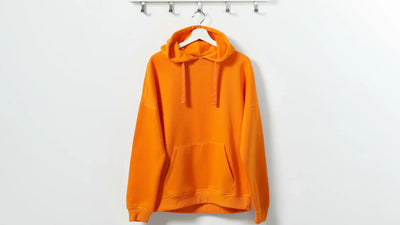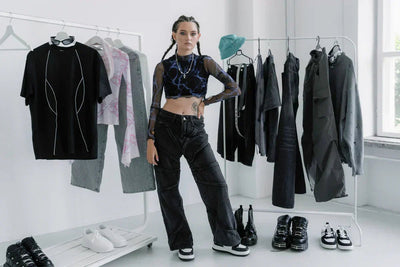
Buying clothing items from the wrong source can ruin your brand – Read before you order!
Sourcing clothing can be a real challenge. The big guys don’t want to work with you, and you end up on a well-known wholesale website somewhere in China, India, or Turkey. Sourcing clothing from websites like “Alibaba” or “Made in China” can seem like a great way to cut costs and easily scale your brand - until it goes horribly wrong. From misleading product listings to poor materials, missing quality control and unexpected delays, many brands have learned the hard way that one bad supplier - one bad decision - can do serious damage.
We ourselves experienced firsthand how unreliable suppliers and bad business practices can put your brand in a very tough spot or - even out of business. Use this information to make good decisions and avoid the same mistakes so many have made before.
Key Takeaways in this article :
- Why cheap often is just that - cheap
- Why cheap is often more expensive
- The hidden pitfalls of large wholesale platforms
- How bad choices can delay your success for months even years
- How unreliable suppliers can still get away with bad practices
- How missing quality standards can ruin your reputation
- How customs regulations can put a stop to your delivery
- You need to know the import requirements for your country
Let’s dive in.
Product Pictures: What You See Isn’t What You Get
When considering platforms like Alibaba, you will first spend hours and hours looking through thousands of products from different manufacturers until your browser has so many windows open that it collapses. But in a couple of days, you may have narrowed it down to the top 10 suppliers. Then you start to create your Excel sheet with the products you’re interested in. Some of the pictures look really promising. But wait a minute - that picture looks familiar! Where did I see that before...? Oh, wait, that is a photo from the original website of my favorite brand, only the logo has been removed with Photoshop!
Unfortunately, this is common practice on Alibaba and other similar platforms. Even though Alibaba claims they do their best to fight those practices, they don’t stand a chance, it seems. So what does this mean for you? You based your decision on the product picture, right? But if this is not an actual picture of the supplier’s product - what is it that you are actually ordering? In that case, you won’t know until it arrives.
Additional charges that can double the price of items
So you decide to go ahead and order samples, ideally with your brand’s logo on them, which usually comes with additional charges. You order your black oversized hoodies, your white oversized t-shirts, and some other items with your logo. You choose different sizes too, of course, because you need to see how they fit.
Now that the order is ready, the supplier will prepare the summary for you. But suddenly, the total amount is a lot more than you thought it would be. How? What happened? Well, they added the shipping from China, which can be costly and, in some cases, double the price of an item. Especially if you chose airfreight instead of sea freight. Sea freight is a cheaper but takes months to arrive. So you go with Express air freight. And that is sometimes so expensive that it can double the price of your item. And if you did not provide your VAT number, tax ID or your resale certificate - they also have to charge you taxes. That’s the law.
Long Delivery Times: Delays That Can Kill Timelines
Since you have not really a choice you accept and you go ahead and pay. And then you wait. And you wait some more. The tracking number doesn’t really provide any updates. After two weeks of researching and another 3 - 4 weeks of shipping time - the products finally arrive.
Quality Issues with Materials: Cheap Fabrics That Fall Apart or Fade Fast
It feels like Christmas morning, and you rip open the packages. You open the box and find the clothes neatly packed in plastic bags with Chinese letters, but you’re lucky and you can identify the products. Then you unpack everything and you realize the fabrics are a lot thinner than you were expecting. So are the colors.
You’re looking at the product in disbelief - is this what I ordered? Well, it must be. But it doesn’t look and feel like I hoped. Now you look at the logos and print designs.
Inaccurate Printing: Blurry, Misaligned Designs or Print Residues
The logo on the T shirt is not centered as it should be - it is misaligned. On the other residue from the printing. Does this come off? On this one, it looks like there is a burn mark from the heat press. And on the shorts the logo is already peeling off. Excitement fades.
Chaos in Clothing Sizes: Inconsistent Sizing
Next are the shorts. You try on the L that you ordered for yourself, but it doesn’t feel like an L - you can barely fit your legs in there. This feels like an S. Did they send the wrong size? The package says L. But luckily, you ordered other sizes. Soon, you realize none of them fit you. Great. So there is obviously a miscommunication with the sizes.
Oh, look! There it is! The crown jewel - the custom black hoodie with your logo on it!
Use of Chemicals
Your favorite item looks somehow a little cheap and not as exclusive as you wanted it to look. It also has a bit of a chemical smell. And there’s an oily spot on there. Many suppliers use harsh chemicals in dyeing, leading to strong odors in the finished products.
All in all, it’s very disappointing because you had such high hopes.
The Never-Ending Sample Process
And now, after you have spent several hundred dollars on those samples and waited for two months - what now? All this leaves you with a lot more questions than answers:
- What will my customers think if they unpack this?
- Will this come off?
- Was that an oversight?
- Will the smell go away if I leave it out in the open for a bit?
- Was the machine not properly adjusted when they pressed the logo on?
- Will they be more careful when I place the big order of 300 pcs MOQ?
So you contact your supplier looking for answers - and they have them. Answers like, “Sorry, this was only on the sample. In the big order, everything will be fine and perfect. We wanted to speed up the process for you so you don’t have to wait so long...” Really? Are you willing to bet your money on that? Why wasn’t it done correctly in the first place? What do you do now?
Continue reading part 2 of this article here :
Frequently Asked Questions (FAQ) About Clothing Sourcing
What are the biggest risks of buying clothing from cheap suppliers?
The most common risks include inconsistent product quality, long shipping times, hidden costs, unreliable customer service, and potential legal issues with import regulations. A “cheap” order can end up costing you more in the long run due to returned products, refunds, and delays.
What’s the best way to verify product quality before committing to a large order?
Always request multiple samples before placing a bulk order. Test the fabric for shrinkage, fading, and durability. Wash and wear the sample several times to check for peeling logos, weak seams, or fabric pilling. If possible, visit the manufacturer in person or hire a third-party quality inspection service.
How do I find trustworthy manufacturers that offer high-quality products?
Networking is key - rely on industry connections, trade fairs, and verified sourcing agencies. European manufacturers often follow strict quality regulations, making them a safer bet. Working with a sourcing expert, agency, or network like Athleisure Basics that has pre-vetted factories can also save you months of trial and error and thousands of dollars.
Why do sample orders cost so much more than bulk orders?
Samples are often handmade or produced in very small quantities, so suppliers charge extra to cover labor, material waste, and production setup. Additionally, customization (like adding your logo) usually comes with an extra fee.
What are common quality issues with overseas clothing suppliers?
Typical problems include incorrect sizing (Asian sizes often run small), fading or peeling prints, loose stitching, and synthetic fabrics being falsely labeled as cotton. Many suppliers also use harsh chemicals in dyeing, leading to strong odors in finished products.
How do I avoid fabric shrinkage, fading, or peeling prints on my products?
Specify fabric pre-shrinking and colorfastness tests in your order agreement. Request high-quality printing methods like screen printing or embroidery instead of cheap heat transfers.
How do I ensure that my products meet quality standards before production starts?
Provide detailed technical specifications, including fabric weight, stitching type, and print methods. Request pre-production samples and have a third-party inspector check production before shipping.



Leave a comment
This site is protected by hCaptcha and the hCaptcha Privacy Policy and Terms of Service apply.